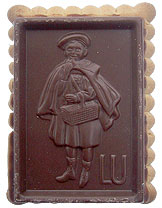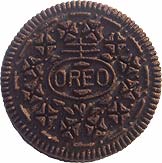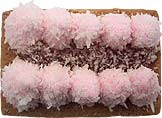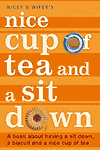Petit Écolier | | Saturday 8 Mar 2003 |

 | What happens when you take an unremarkable biscuit, slap a big old lump of chocolate on it and call it rather dubiously a 'small schoolboy'? Well, you get the flagship biscuit for leading French biscuit manufacturer LU. As Gallic as a three hour lunch break or a terrifyingly constructed road junction, the Petit Écolier is not a biscuit that I would expect to see in our shops anytime soon.
On first encountering the Petit Écolier it appears bizarre, having embossed onto its slab of chocolate an odd looking child carrying a basket. On further investigation it turns out that the lad in question is called Jacques, son of poster artist Firmin Bouisset and painted by him in 1897. The baker and biscuit maker LU was founded by the husband and wife team of Pauline Utile and Jean-Romain Lefèvre, in the Tourane region of France, their surnames giving rise to the company name. They adopted the image of the little school boy, originally pictured eating straight forward Petit Beurre, over the even madder image of a flying trumpeting laurel distributing angel type woman. Back in the 19th century the little chap must have thought Petit Beurres were cutting edge biscuit heaven. Nowadays they are ranked somewhat below balsa wood, charcoal briquettes and airline food in the league table of appetising things to eat.
Back to the Petit Écolier. Well there is something decidedly disjointed about it. The chocolate and biscuit are very obviously created separately then quickly fused together to create the finished item. Whilst the edge of the slab is firmly attached, underneath it gaps abound. Whilst I can appreciate the technical imperatives for this, the result is a bit like eating a packet of rich teas whilst stealing bites off a block of dairy milk chocolate. The taste is pleasant enough, as the dreary old Petit Beurre is easily drowned out by the slab of good quality chocolate. However the overall effect is unsettling as it seems that the Petit Beurre has acquired the chocolate out of desperation, and indeed the slab may choose to up and leave at any moment if it gets a better offer, which seems likely.
As one might expect with such an elaborate biscuit, it ships in a little cardboard box with a tray insert, a dozen to a pack. Different versions exist, milk, plain chocolate, caramel flavoured, or hazelnut. All of these have their own elusive charm, but given the almost transitory nature of the biscuit and chocolate coupling, I can easily imagine other toppings replacing the chocolate, sardine or radish for example. |
| Oreo | | Saturday 22 Feb 2003 |

 | Oh dear, oh dear, oh dear. I didn't mean to review the Oreo this week, it just sort of happend, due to my intended biscuit not being on the shelves in Sainbury's. So lets take a look at what the great all American biscuit, (naturally it thinks its a cookie) can offer the rest of the free world.
Baked by Nabisco, (National Biscuit Company) since its founding in 1898, and currently selling at the rate of 11 billion biscuits a year, the Oreo proudly proclaims itself the world's number 1 biscuit. Nowadays Nabisco is part of Kraft foods which is part of the Philip Morris group of companies (recently renamed to Altria Group), who own most brands of cigarettes, coffee, chocolate and snack foods you can think of. Marlboro, Benson & Hedges, Maxwell House, Dairylea, Milka, Terry's, Kenco, Planters, Vegemite and Ritz, to name just a very very few. Altria are also the largest shareholder in world's second-largest brewer, SABMiller. Nabisco bakes the Oreo world wide, our review pack being baked in Spain. The Oreo is basically an imperial juggernaut of a biscuit, whose stable mate brands use nicotine, alcohol, caffeine, fat and sugar to appeal to consumers. If you are looking for that lovingly home baked taste you really have come to the wrong place.
So what can we say about the Oreo as a biscuit other than its capitalist credentials? Well its main ingredient is sugar and it consists of two rather sickly dark cocoa biscuits, bearing the company logo, back to back with some white sugary creme stuff in between. Variants are available where the creme is flavoured with coffee, mint etc. There are also ones that have been covered in fudge of various types. Can you feel your arteries hardening as you read this?
The pack absurdly comes with eating instructions, of which there are six stages. I won't detail them all but basically you are encouraged to wrench the thing into its component parts. What is the point of assembling it in the first place if you have to take it all to bits to eat it? Well I'm assuming this is what Altria refers to as "Marketing Excellence: Expertise and imagination applied by our consumer packaged goods companies in the development of outstanding consumer brands." This statement is number two on the list of what Atria stands for. As an un-initiated limey I would call it something a lot more colourful and Anglo Saxon.
I'm also gratified to see that the pack describes the contents as biscuits not cookies, maybe because its a localised Euro pack, but then again they are made by Nabisco not Nacooco. The Oreo website actually has quite a lot of facts and figures, which we are keen on. The problem is that none of them actually made sense or corresponded to each other. The figure of 49 billion Oreos does indeed get you to the moon and 6 times if you stack them on end. However, if they sell 11 billion a year and they have sold 49 billion in total then they must be enjoying phenomenal growth. They also mention that they have sold 4.9 billion on average every year. Well as we have seen they are over 100 years old, so I make that getting on for 5 trillion Oreos.
So to wrap up, if you want to make a protest against globalisation through the medium of biscuits then the Oreo is the chappy. Simply stand in front of them in your supermarket and prevent other shoppers from picking them up. Your feedback 24 messages |
| Jacob's Mikado | | Wednesday 12 Feb 2003 |
 | This biscuit review very nearly didn't happen. As you may know, the Wife went on a mission to Ireland to retrieve the Mikado, and on the way back we suspect they took an unplanned trip via Innsbruck Austria. They finally arrived the next day couriered up from the airport. As we have mentioned before Jacobs operate two bakeries, one in Liverpool and the other across the Irish sea in Dublin. Despite our Mikados being bought in Ireland it was not possible to tell which side of the water they were baked.
Now there has already been some debate about Mikados and the oddity that there are two sorts of Mikado, a tall straw like affair and the marshmallow variety seen here. Whilst in France I glimpsed the tall variety in a supermarket but alas was unable to secure a packet. However, this sighting in the wild shows that there is still a bakery someplace knocking them out.
Now to the biscuit at hand. The Mikado is classically associated with children's birthday parties, where it provides a staple source of marshmallow and jam. I always have reservations about the use of coconut in biscuits which seems more of a nod towards dietary fiber content rather than flavour, however, in the Mikado the tartness of the simulated raspberry jam (its actually apple), keeps the coconut at bay. The biscuit base is quite soft, with a crunch nowhere to be found. It does manage to sport some grid like biscuit graphics, so it does appear to have some sort of mechanical properties. The pink marshmallow is arranged in two rows, five blobs in each. The jam provides us with a mystery which is quite difficult to see in our picture, but biscuit carries three blobs but arranged in a four blob central row with the second blob missing. Did our biscuits come from a faulty batch? Is this a cost cutting measure or is this deliberate?
So what is the overall effect of all of this tea time treat technology? Well its possibly the closest thing in the biscuit world to a salad. Having said that the younger members of staff destroyed their ration of review biscuits at an impressive rate and even asked nicely for more, so it appears that the Mikado has lost none of its party time magic.
Edit: Previously the Wife thought the Mikado was called a 'Kimberly Mikado', due to her memory of an Irish TV advert. In fact they are two different biscuits both members of the flagship trilogy of biscuits created by Jacob's, 'The Kimberly', 'The Mikado' and 'The Coconut Cream', all imortalised by the jingle in the advertisement shown on Irish television during the eighties "Kimberly, Mikado and Coconut Cream, someone you love, would love some Mum!". Thanks to James Thomas and others who put us right on this. Your feedback 7 messages |
| |
|
|








